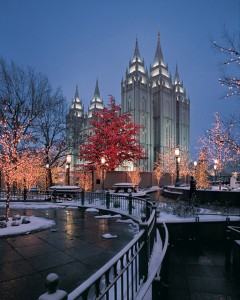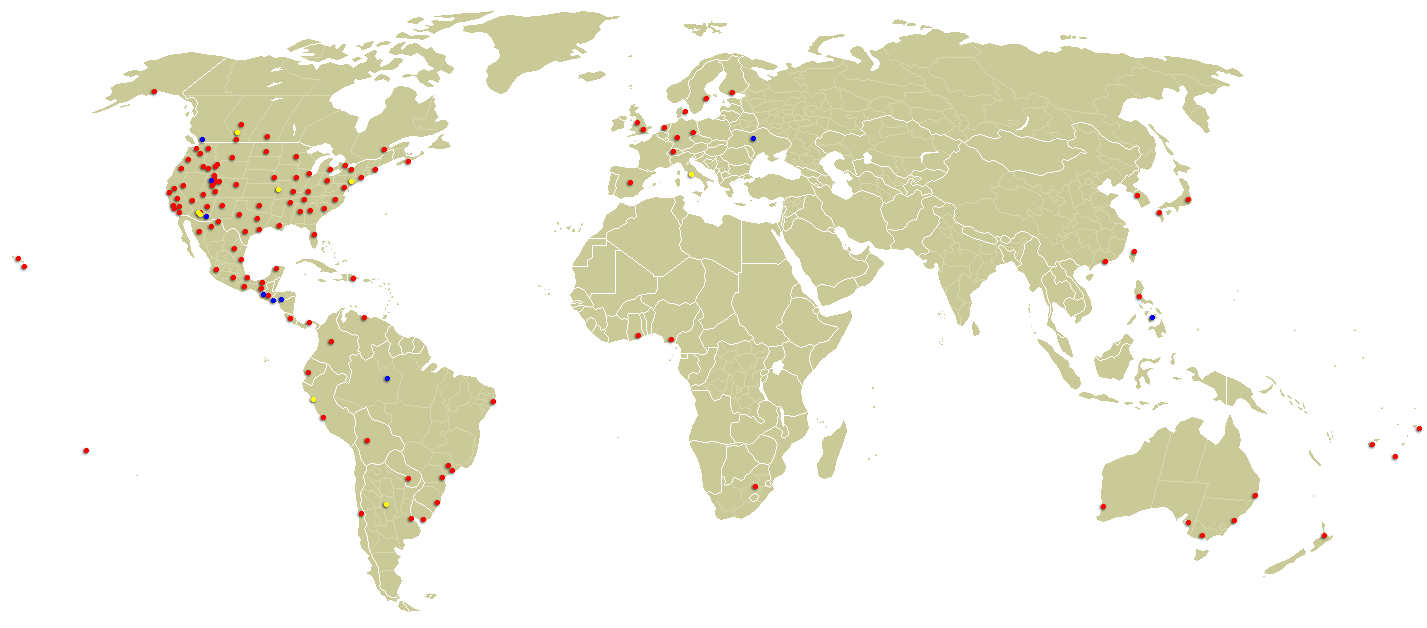 By 2006, there were 122 operating temples, with twelve more either in the planning or construction phase. President Gordon B. Hinckley said that the pace will slow from the tremendous surge seen in the late 1990s and early 2000s, but will continue until there are enough temples to dot the earth and to bless all of God’s children. Currently there are Mormon temples in dozens of countries. There are three Mormon temples in Africa, six in Asia (including Japan, Korea, Taiwan, China, and the Philippines), ten in Australia and Oceania, nine in Europe, and sixteen in Central and South America. In North America, there are 78 Mormon temples, with six in Canada, and twelve in Mexico. In the United States, there are 60 Mormon temples. Twelve states–Arizona, California, Hawaii, Idaho, Illinois, Nevada, New York, Oregon, Tennessee, Texas, Utah, and Washington–have more than one. Utah has eleven temples, California has six, Texas has four, Washington has 3, and Arizona, Hawaii, Idaho, Illinois, Nevada, Oregon, Tennessee, and Texas each have two. Twenty other states have one Mormon temple each.
By 2006, there were 122 operating temples, with twelve more either in the planning or construction phase. President Gordon B. Hinckley said that the pace will slow from the tremendous surge seen in the late 1990s and early 2000s, but will continue until there are enough temples to dot the earth and to bless all of God’s children. Currently there are Mormon temples in dozens of countries. There are three Mormon temples in Africa, six in Asia (including Japan, Korea, Taiwan, China, and the Philippines), ten in Australia and Oceania, nine in Europe, and sixteen in Central and South America. In North America, there are 78 Mormon temples, with six in Canada, and twelve in Mexico. In the United States, there are 60 Mormon temples. Twelve states–Arizona, California, Hawaii, Idaho, Illinois, Nevada, New York, Oregon, Tennessee, Texas, Utah, and Washington–have more than one. Utah has eleven temples, California has six, Texas has four, Washington has 3, and Arizona, Hawaii, Idaho, Illinois, Nevada, Oregon, Tennessee, and Texas each have two. Twenty other states have one Mormon temple each.
Each Mormon temple is built to exact standards, much as Solomon built his temple with the best materials he could obtain as a way to honor the Lord and create a place that reflects God’s glory. Mormon temples symbolize Mormon belief about the links between generations and between heaven and earth. They represent the belief that life continues beyond the grave and that families, through the sacred power of the Holy Priesthood, can be sealed together for time and for all eternity and that they can dwell together with God and Jesus Christ in the highest heaven. Mormon temples are used to perform vicarious ordinances on behalf of the dead and enable each person to return to the presence of God. The path is one of succeeding covenants, or promises, which each person who goes through the Mormon temple ceremonies performs. The covenants instruct the person in their relationship to God, their purpose here on earth, and how to prepare themselves for the life to come. Many Mormons will visit the temple to pray and ponder in the Celestial Room, which is a sacred, holy room set aside for quiet prayer and meditation and designed to typify, in a small way, the glory of God’s Kingdom.
 Mormons will continue to build temples wherever congregations are found. Mormons are also encouraged to prepare themselves and their families to enter the temple and always maintain that worthiness that will permit them to walk among those holy walls. Because the temple is so sacred, only those who are striving to live God’s commandments can enter it. Mormon temples are not secret, but Mormons do not discuss the ordinances of the temple in detail, because they are held to be so sacred. There is not, however, any Mormon belief taught in the temple that is not taught outside the temple; it is the ordinances that are regarded as sacred. Mormons who have been in the temple and made covenants with God to follow His commandments wear sacred undergarments, which outsiders sometimes refer to as “Mormon underwear,” to remind them of their covenants and to strengthen them spiritually throughout their lives. The temple garment is similar in symbolism to the Jewish tzitzit, which has been worn by Jews for thousands of years, and which symbolizes a dedication to live the Law of Moses. The Mormon garment symbolizes a progression of covenants from a basic understanding of sacrifice and obedience to higher principles of chastity and consecration.
Mormons will continue to build temples wherever congregations are found. Mormons are also encouraged to prepare themselves and their families to enter the temple and always maintain that worthiness that will permit them to walk among those holy walls. Because the temple is so sacred, only those who are striving to live God’s commandments can enter it. Mormon temples are not secret, but Mormons do not discuss the ordinances of the temple in detail, because they are held to be so sacred. There is not, however, any Mormon belief taught in the temple that is not taught outside the temple; it is the ordinances that are regarded as sacred. Mormons who have been in the temple and made covenants with God to follow His commandments wear sacred undergarments, which outsiders sometimes refer to as “Mormon underwear,” to remind them of their covenants and to strengthen them spiritually throughout their lives. The temple garment is similar in symbolism to the Jewish tzitzit, which has been worn by Jews for thousands of years, and which symbolizes a dedication to live the Law of Moses. The Mormon garment symbolizes a progression of covenants from a basic understanding of sacrifice and obedience to higher principles of chastity and consecration.
About Anita Stansfield
Anita Stansfield began writing at the age of sixteen, and her first novel was published sixteen years later. For more than fifteen years she has been the number-one best-selling author of women’s fiction in the LDS market. Her novels range from historical to contemporary and cover a wide gamut of social and emotional issues that explore the human experience through memorable characters and unpredictable plots. She has received many awards, including a special award for pioneering new ground in LDS fiction, the Lifetime Achievement Award from the Whitney Academy for LDS Literature, and also a Lifetime Achievement Award from her publisher, Covenant Communications. She has fifty-six published books. Anita is the mother of five, and has three grandchildren.



 Watch a video about the restoration of the gospel on lds.org
Watch a video about the restoration of the gospel on lds.org